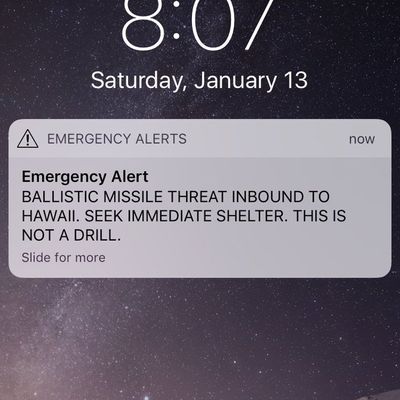
Stunned Hawaiians received a terrifying emergency alert on their mobile devices and television screens early Saturday morning warning them of a “ballistic missile threat inbound to Hawaii” and telling them to “seek immediate shelter.” The mistaken alert, which reached an unknown number of people in the state just after 8 a.m. local time, even indicated that “This is not a drill”:
An automated television message was sent out, too, announcing that
“The U.S. Pacific Command has detected a missile threat to Hawaii.” The scrolling message and automated voice continued:
A missile may impact on land or sea within minutes. This is not a drill. If you are indoors, stay indoors. If you are outdoors, seek immediate shelter in a building. Remain indoors well away from windows. If you are driving, pull safely to the side of the road and seek shelter in a building or lay on the floor. We will announce when the threat has ended. This is not a drill. Take immediate action measures.
Congresswoman Tulsi Gabbard quickly checked on the threat and determined it was a false alarm:
The false alert, which did not trigger the state’s emergency sirens, was due to human error and the U.S. Pacific Command quickly confirmed that it had detected no missiles. According to Hawaii governor David Ige, a staff member at the state’s Emergency Management Agency accidentally pressed the wrong button while employees were doing a check of the emergency-alert system during a shift change. Ige later announced that the procedure for sending the alert will be changed “so that a single person will not be able to make an error that triggers another false alarm.”
The mistaken warning produced considerable panic in Hawaii on Saturday morning as people scrambled to find shelter or be together with their loved ones. There are many reports of residents and tourists breaking down crying in shelters or on their phones with family members, terrified that they were about to die. Hawaii state representative Matt LoPresti told CNN about his experience huddling with his children in the bathtub of his home following the alert:
He was just one of many Hawaiians who took the message seriously:
But not everyone in the state panicked:
Tensions in the state were already high. Hawaii has recently been testing its missile alerts for the first time since the Cold War following North Korea’s threats to fire a nuclear warhead at the U.S. Last year, North Korea conducted successful tests of ballistic missiles that could conceivably carry such a weapon to Hawaii or the mainland U.S. And just two weeks ago, President Trump taunted Kim Jong Un about the inferior size and power of the North Korean leader’s nuclear button.
While Hawaii’s Emergency Management Agency apparently started calling TV stations as soon as it realized its mistake on Saturday, it nonetheless took a long time — almost 40 minutes — to send a follow-up mobile alert:
Senator Mazie Hirono quickly expressed her outrage on Twitter, too — one of many subsequent calls from officials to fix the alert system in order to prevent such errors:
And, as New York Times national-security correspondent David Sanger pointed out on Saturday, the mistake also illustrates a key technological difference between now and the Cold War when it comes to these warning systems:
This post has been updated throughout to reflect new information regarding the false alarm.






























